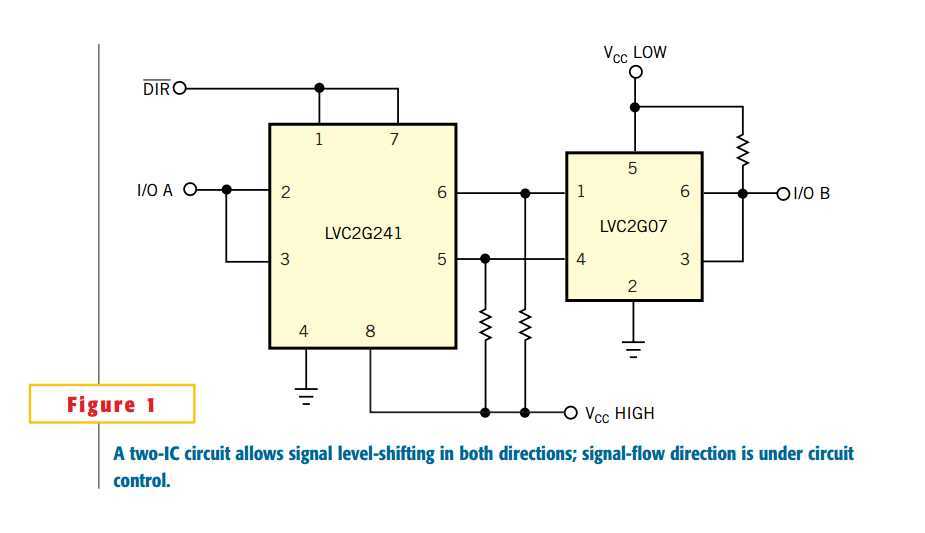标签:blog http io ar os sp for on 2014

In new mixed-voltage systems, it is often necessary to level-shift a control signal from a high level to a low level. An open-drain device, such as the 74LVC1G07, easily performs this shift. However, when a bidirectional signal requires level-shifting, it takes a bit more circuitry, because simply tying two open-drain devices pins together generates just a latch function.
The circuit in Figure 1 shows how to connect the 74LVC2G241 and 74LVC2G07 devices together to shift the signal at A from a high level to a low voltage at B and to shift a low level at B to a higher level at A. The ![]() signal controls the direction of the transfer. When
signal controls the direction of the transfer. When ![]() is low, the A side is the input, and the B side is output. When
is low, the A side is the input, and the B side is output. When ![]() is high, B becomes the input, and A becomes the output. To have B behave as an input when the
is high, B becomes the input, and A becomes the output. To have B behave as an input when the ![]() signal is low, redo the circuit so that Pin 3 of the 74LVC2G241 becomes the input to Pin 1 of the 74LVC2G07 and Pin 4 of the 74LVC2G07 becomes the input to Pin 2 of the 74LVC2G241.
signal is low, redo the circuit so that Pin 3 of the 74LVC2G241 becomes the input to Pin 1 of the 74LVC2G07 and Pin 4 of the 74LVC2G07 becomes the input to Pin 2 of the 74LVC2G241.
The highest voltage VCC should supply the 74LVC2G241, and the lowest voltage level supply necessary should supply the 74LVC2G07. For example, to shift a signal from 3.3 to 1.8V, the 1.8VCC should supply the 74LVC2G07 device. The size of the pullup resistor is unimportant, but, for best speed, it should be as small as practical to reduce the RC change time of the output signal of the 74LVC2G07. The current output of the 74LVC07A is 24 mA at 3.3V; at that VCC, the pullup resistor could be as low as 150Ω. It should be as large as possible to reduce power consumption.
The 74LVC2G07 supply level determines VOL and VOH at B. At 1.8V, the VOH would be near VCC, and VOL is 0.45V or lower when driving a 4-mA load. The 74LVC2G07 and 74LVC2G241 provide a quick and easy way to obtain a bidirectional level translation and take up little board space.
Use two picogate devices for bidirectional level-shifting
标签:blog http io ar os sp for on 2014
原文地址:http://www.cnblogs.com/shangdawei/p/4128228.html